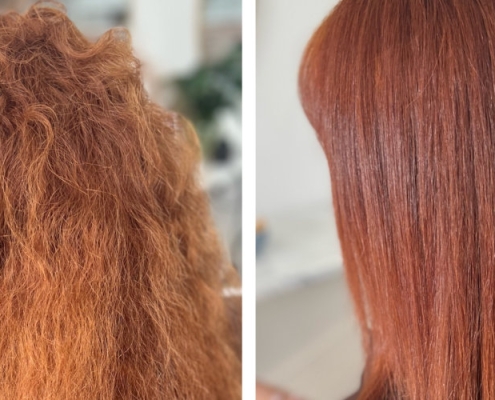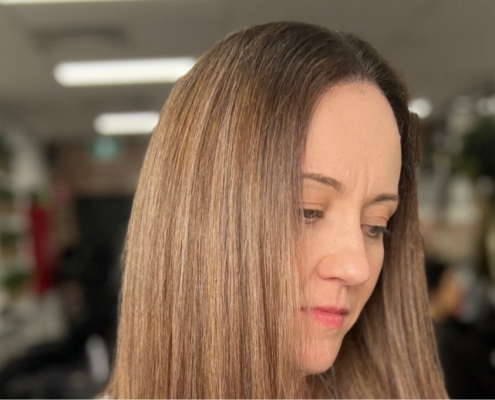Does Nanoplasty Really Last? Only If It’s Done Properly
Nanoplasty is known for delivering long-lasting results — soft, smooth, frizz-free hair that can last up to 7 months. But not everyone experiences the same outcome. While some clients enjoy silky, manageable hair for months, others find their hair reverting to its previous state after just a few washes.
So what’s the difference? It all comes down to how the treatment is performed, the quality of the product, and how well aftercare is followed. When Nanoplasty doesn’t last, it’s almost always due to incorrect technique, poor product choice, or lack of guidance — not because the treatment itself is faulty.
At The Cutting Room, we’ve performed thousands of Nanoplasty treatments and helped many clients recover from disappointing results elsewhere. If you’re wondering whether Nanoplasty really lives up to the hype, this article will help you understand what impacts longevity — and how to make your results last.
Let’s explore the most important factors that determine how long Nanoplasty will last on your hair.
1. Application Technique Matters More Than You Think
The most common reason Nanoplasty wears off too soon? It wasn’t applied properly. Like many smoothing treatments, Nanoplasty requires a precise application method — from how the product is layered onto the hair to how long it processes and how the heat is applied to seal it in.
At The Cutting Room, Nanoplasty is applied directly to dry hair — not washed beforehand — because this allows the product to coat each strand evenly and absorb effectively. Applying it to damp or shampooed hair can interfere with its performance and dilute the smoothing agents.
If the stylist doesn’t understand how to work with dry hair or rushes through the sealing process, the treatment won’t take properly. The result? Smoothness that fades quickly, or uneven texture that doesn’t last.
We once had a client visit us after a previous Nanoplasty that “washed out” after a week. After assessing her hair, we discovered the treatment hadn’t been left on long enough, and the heat sealing process had been rushed. She thought Nanoplasty just “didn’t work for her hair” — but in reality, it had never been properly applied in the first place.
Key issues caused by poor technique:
- Insufficient processing time
- Uneven product distribution
- Incorrect rinsing method
- Improper or rushed flat ironing
To learn more about how technique impacts results, read Why Your Nanoplasty Didn’t Work.
2. The Right Heat Sealing Is Critical
Nanoplasty is heat-activated — which means flat ironing is not just the final step; it’s essential to locking in the treatment. However, the temperature must be tailored to your hair type. Too little heat means the product doesn’t bond properly. Too much heat can cause damage and shorten the treatment’s effectiveness.
At The Cutting Room, we use professional-grade flat irons with adjustable temperatures, and we base our settings on factors like hair thickness, condition, and colour history. For example, fine or previously bleached hair may require a lower heat setting and more gentle passes with the iron, while thick, coarse hair might need a slightly higher temperature and more sealing time.
Unfortunately, many stylists (especially untrained ones) use a one-size-fits-all approach — often blasting every client’s hair with extreme heat. Not only can this damage your hair, but it also doesn’t guarantee better results. Worse, it can cause breakage and strip colour if not done carefully.
Why proper heat technique matters:
- Ensures long-lasting smoothness and shine
- Prevents damage to delicate or colour-treated hair
- Creates a consistent, frizz-free result that lasts up to 7 months
Think your hair was overheated or damaged during treatment? Learn more in Signs Nanoplasty Was Done Wrong.
3. Aftercare Plays a Big Role in Longevity
Even a perfectly applied Nanoplasty treatment can wear off quickly if it’s not maintained correctly. What you do after you leave the salon directly affects how long your results last. Using the wrong shampoo, heat-styling carelessly, or failing to protect your hair from chlorine or salt water can all cut the treatment’s lifespan dramatically.
We always recommend using sulfate-free, low-pH shampoos and nourishing conditioners that are compatible with smoothing treatments. These preserve the integrity of the Nanoplasty and keep your hair feeling silky and manageable for longer. Using regular supermarket shampoos loaded with sulfates or silicones can weaken the smoothing effects within weeks.
Another common mistake? Bleaching or colouring your hair too soon after treatment. This can disrupt the internal structure of your hair and significantly shorten the lifespan of your Nanoplasty. We recommend waiting at least two weeks post-treatment before any colouring — and longer for bleaching or lightening.
What helps Nanoplasty last:
- Sulfate-free shampoo and conditioner
- Heat protection during styling
- Waiting 2–4 weeks before colouring or bleaching
- Minimising exposure to chlorine and sea water
For more maintenance tips, see our Expert Aftercare Tips for Nanoplasty.
4. Product Quality and Authenticity Matter
Not all “Nanoplasty” treatments are created equal. Unfortunately, there are knock-off products and low-grade formulations that don’t deliver long-lasting results — even if they’re labelled as Nanoplasty. In budget salons or home setups, stylists may use unregulated or diluted versions that produce a temporary result but quickly wear off.
We once had a client who said her previous Nanoplasty “felt great at first,” but within two weeks, her frizz had returned. On closer inspection, the product used wasn’t a true Nanoplasty formula — it was a generic smoothing product mislabelled to sound more appealing. This is a common issue in unregulated environments where product quality varies widely.
At The Cutting Room, we only use professional-grade Nanoplasty products with proven, formaldehyde-free formulations. These have been tested on all hair types and consistently deliver long-lasting, safe, and beautiful results. Choosing an experienced salon ensures you’re getting the real thing — not an imitation.
Signs you may have received an inferior product:
- Frizz or puffiness returns within 2–3 weeks
- Your hair feels waxy, heavy, or overly coated
- There was no aftercare guidance provided
Read more about the risks of unregulated products in The Dangers of DIY Nanoplasty.
5. Hair Type and History Can Influence Results
While Nanoplasty works on most hair types, your hair’s condition, texture, and chemical history all play a role in how long the results last. Thick, curly hair may experience a regrowth look sooner than straight or wavy hair. Similarly, overly damaged or porous hair may absorb the treatment differently, affecting how long it stays smooth and frizz-free.
That’s why we always start with a detailed consultation. We’ll ask questions about your colour history, past treatments, hair routine, and goals — and then tailor the Nanoplasty accordingly. If you’ve recently bleached or chemically straightened your hair, we may recommend spacing out your treatments or modifying your aftercare plan.
Clients who follow personalised advice and come in with realistic expectations tend to see the best results. In contrast, those who skip consultation, rush the process, or jump from one treatment to the next often end up with disappointing longevity.
Factors that can affect results:
- Very curly hair may show regrowth sooner
- Previously bleached or damaged hair may require extra care
- Clients with oily hair may need specific product recommendations
Find out how Nanoplasty works on different hair types in Nanoplasty for Different Hair Types.
So, Does Nanoplasty Really Last?
Yes — when it’s done properly, Nanoplasty delivers stunning, smooth, and long-lasting results. Most clients enjoy 5 to 7 months of frizz-free hair that’s easier to manage, faster to style, and more resistant to humidity. But achieving that longevity isn’t just about the product — it’s about the whole process.
From product quality and stylist experience to heat application and at-home care, every step matters. Cutting corners or trusting unqualified providers often leads to poor results and wasted money — but in the hands of a trained professional, Nanoplasty can be a truly transformative treatment.
If your last experience with Nanoplasty didn’t last, we’re here to help. At The Cutting Room, we’ve helped hundreds of clients restore their confidence and love their hair again — for the long haul.
Not sure if Nanoplasty is right for you? Get started with 7 Questions to Ask Before Booking Nanoplasty.
Book your consultation today and let’s make your results last.













